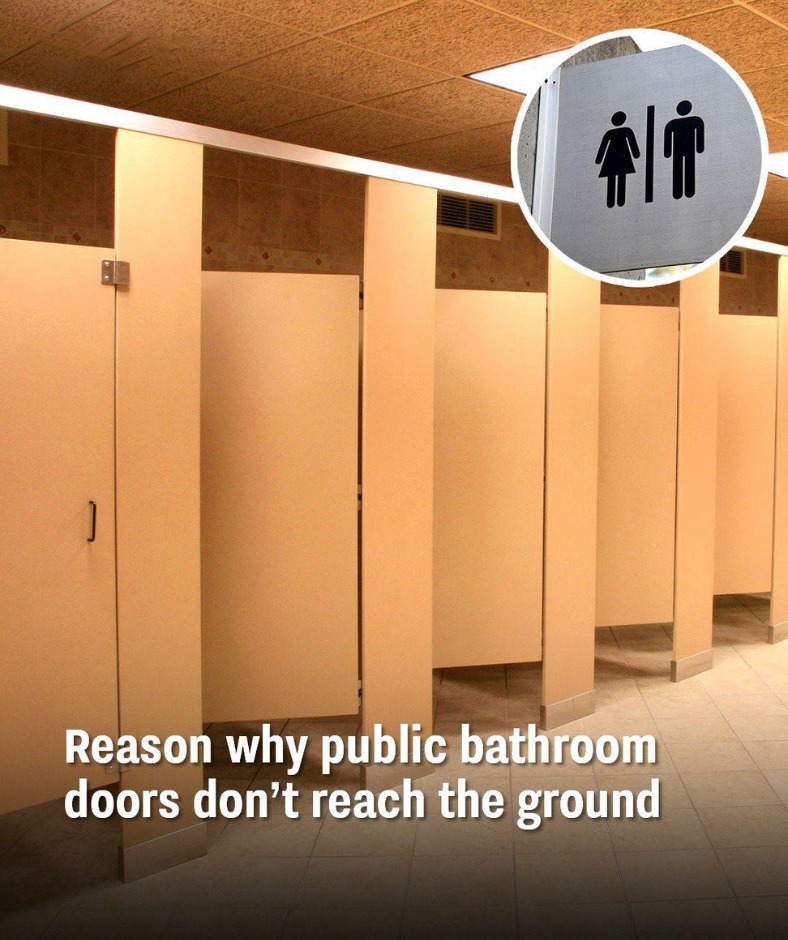Have you ever wondered why public restroom stall doors don’t reach the floor? At first glance, it might seem like a strange design choice, but there’s a well-thought-out reason behind it. What might appear to be a quirk of design is actually a series of deliberate choices made for safety, practicality, and cost efficiency. Let’s explore why these gaps exist and the practical purposes they serve.

One of the most critical reasons for raised restroom stall doors is emergency access. In situations where someone inside a stall might need urgent help, the gap at the bottom of the door allows others to quickly see what’s happening and provide assistance. TikTok user MattypStories put it succinctly: “If there’s ever an emergency, it would be pretty easy to see what happened and get the person some help.” This small feature can make a big difference in critical moments, offering an immediate way to assess and respond to emergencies.
Another major benefit of the raised design is easier cleaning. Maintaining cleanliness in high-traffic public restrooms is crucial, and the gap at the bottom of stall doors allows custodians to clean the floors more effectively. Mops, brooms, and even pressure washers can easily slide under the doors without obstruction, streamlining the cleaning process. Toilet fitting company ToiletPartitions notes that this open design allows for quicker and more thorough cleaning, ensuring hygiene standards are met with less hassle.
Cost-effectiveness is another significant factor in why public bathroom stall doors don’t touch the floor. Full-length doors are not only more expensive to manufacture but also costlier to install and maintain. By opting for shorter doors, builders can save on materials and labor costs. As MattypStories explains, “It’s a lot cheaper to buy a door that has part of it cut off than the full door itself.” This budget-friendly design choice reduces the overall expense of constructing and maintaining public restrooms without sacrificing functionality.
The design also promotes better air circulation, which is essential in public restrooms. The gap at the bottom of the doors helps odors dissipate more quickly by allowing fresh air to circulate. According to WC Portables, “The gap between the door and the floor provides a quick escape of the foul smell that was generated by previous users.” This feature not only improves the atmosphere of the restroom but also ensures a more pleasant experience for everyone who uses it.
In addition to practical benefits, raised doors help prevent misbehavior. Public restrooms, unfortunately, can sometimes become sites of inappropriate activities. The reduced privacy provided by shorter doors acts as a deterrent, making it easier for others to notice and discourage such behavior. WC Portables highlights this advantage, noting that “shorter doors help ensure the toilet queue flows and people refrain from exhibiting poor behavior due to the embarrassment of being spotted.”
The design also addresses potential issues with door malfunctions. If a stall door lock jams or the door becomes stuck, the gap at the bottom provides an easy way for someone to escape by crawling out. This feature eliminates the fear of being trapped inside, offering peace of mind to restroom users. As one commenter noted, “If the door gets stuck, you can crawl out.”
Another subtle but practical advantage is that the gap makes it easier to determine if a stall is occupied. Instead of awkwardly knocking on doors or attempting to open one that might be in use, a quick glance at the floor can confirm whether someone is inside. As ToiletPartitions explains, “Rather than having to knock on the door to see if a public bathroom is available, a gap at the end of the stall helps to determine if the stall is vacant or not.”
Interestingly, the reduced privacy created by the raised doors can also encourage faster turnover. With less privacy, people tend to complete their restroom business more quickly, reducing wait times for others. WC Portables observes, “When individuals sense others can listen to their business that easily, they are prone to wrap up quickly.” This results in a more efficient use of public facilities, especially during busy times.
Lastly, the gap provides a simple way to offer assistance if needed. For example, if someone inside the stall runs out of toilet paper, it’s much easier to pass supplies under the door. This small design feature ensures that minor inconveniences can be resolved without unnecessary frustration or awkwardness.
While the design of public restroom stall doors might initially seem puzzling, the reasons behind it are both practical and thoughtful. From ensuring safety and facilitating cleaning to improving air circulation and saving costs, the raised door design serves multiple purposes. It’s a smart solution to the unique challenges of managing public restrooms, balancing functionality with practicality. The next time you find yourself in a public restroom, you’ll have a newfound appreciation for the careful considerations behind this seemingly odd design choice.





